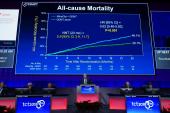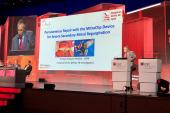RESHAPE-HF2 Is a Win for MitraClip in FMR—Not Everyone’s On Board
(UPDATED) A flurry of papers, including a meta-analysis of the three RCTs, reflect big interest and even larger, unanswered questions.

LONDON, England—Anyone hoping that a third “tiebreaker” trial of the MitraClip against optimal medical therapy (OMT) would help clarify the role of transcatheter edge-to-edge repair (TEER) in heart failure patients with functional mitral regurgitation (FMR) may leave the European Society of Cardiology (ESC) Congress 2024 still scratching their heads.
RESHAPE-HF2, the investigator-initiated, 505-patient trial released Saturday at a Hot Line session, has been randomizing patients since 2015 and arrives nearly 6 years after COAPT and MITRA-FR famously delivered conflicting results.
According to Stefan Anker, MD, PhD (Charité Universitätsmedizin Berlin, Germany), who presented RESHAPE-HF2 at ESC, the results are a clear win for the MitraClip (Abbott), which was superior to OMT alone across all three of the trial’s primary endpoints, including the combined endpoint of death or heart failure (HF) hospitalizations. No significant differences, however, were seen for mortality alone.
“We are more or less confirming COAPT, [although] in a somewhat less severe functional MR population, with the one exception that all-cause mortality is not reduced,” Anker commented in a press conference. “This, I think, overall supports the concept that this treatment can be done and, second, suggests that it may be extended to less-than-severe functional MR patients.”
RESHAPE-HF2 was simultaneously published in the New England Journal of Medicine.
But Wait, There’s More
The multiple simultaneous publications in the Journal of the American College of Cardiology to coincide with Saturday’s presentation speak to both the enormous interest in this trial and the persistent unknowns.
One editorial, by COAPT principal investigator Gregg Stone, MD, and Bhavanadhar Penta, MBBS (both Icahn School of Medicine at Mount Sinai, New York, NY), describes RESHAPE-HF2 as “erasing all doubt” that MitraClip trumps OMT in patients with moderate-to-severe MR. While a number of key limitations of RESHAPE-HF2 warrant a cautious interpretation, this latest study relegates MITRA-FR to being “the ‘outlier’ trial”—potentially because the earlier French study enrolled patients with greater left ventricular dilation, they posit.
By contrast, a second editorial by MITRA-FR lead investigator Jean-François Obadia, MD, PhD (Hôpital Cardiovasculaire Louis Pradel, Bron, France), and colleagues questions whether “RESHAPE-HF2 is good enough to be a tiebreaker.”
They describe a litany of trial shortcomings—the multiplicity of endpoints that include HF and CV hospitalizations, increasing the risk of false positives, as well as the liberal definitions for both endpoints; the higher rate of non-CV hospitalizations in the control group; the repeated protocol amendments; the protracted trial duration; the assessment of MR severity; the inclusion of more moderate MR patients; and more. Many of these were also enumerated by Stone and Penta.
“We believe that RESHAPE-HF2 does not end the debate about TEER for MR,” Obadia and colleagues write. “Instead, as one of its main merits, the trial restimulates the discussion.”
I think we confirmed the results for severe MR; for less than severe, this is indicating good news, but it needs to be validated. Stefan Anker
A third JACC editorial, led by Aakriti Gupta, MD (Cedars-Sinai Medical Center, Los Angeles, CA), expands on and extends a volume-overload theory to explain the results, a theory that two of the editorial co-authors have expounded for some time.
“When placed alongside the landmark COAPT and MITRA-FR trials, RESHAPE-HF2 presents outcomes that are part of a coherent narrative explainable through the lens of left ventricular end-diastolic volume,” they write. When LV sizes increase beyond a certain threshold, they say, the MitraClip’s ability to reduce regurgitation falls short of impacting clinical outcomes.
The editorialists also make the point that adherence to guideline-directed medical care differed between trials, with none of them using the now standard four-pillar approach, leaving the door open for studies combining modern-day optimal therapy and TEER.
Key RESHAPE-HF2 Results
Anker and colleagues randomized patients from 30 sites in nine countries to OMT alone (n = 255) or mitral TEER plus OMT (n = 250). All patients had to have 3+ or 4+ FMR, an LVEF of 20% to 50% (although this shifted from 15% to 45% during the trial) and either an HF hospitalization or elevated BNP within 90 days prior to randomization. As previously reported by TCTMD, RESHAPE-HF2’s analysis plan was changed in recent years to have three primary endpoints.
At 24 months, rates of total HF hospitalizations or a composite of HF hospitalizations or CV death, as well as mean change from baseline to 12 months in Kansas City Cardiomyopathy Questionnaire (KCCQ) overall summary score, all favored MitraClip.
RESHAPE-HF2 Primary Endpoints
|
|
TEER + OMT |
OMT |
Rate Ratio/Mean Difference (95% CI) |
|
Hospitalizations for HF or CV Death, per 100 patient-years |
37.0 |
58.9 |
RR 0.64 (0.48-0.85) |
|
HF Hospitalizations, per 100 patient-years |
26.9 |
46.6 |
RR 0.59 (0.42-0.82) |
|
Mean Change in KCCQ Score From Baseline, points |
+21.6 |
+8.0 |
10.9 points (6.8-15.0) |
Over the entire trial follow-up (mean 38.1 months), just over half of the patients died—exactly 142 deaths occurred in each of the two groups. Four patients in the device group experienced adverse events at the time of their interventions.
When he presented the results to the media Friday, Anker acknowledged that RESHAPE-HF2 ultimately enrolled a lower-risk cohort of patients than the earlier two RCTs, with lower rates of kidney disease, lower BNP levels, and smaller effective regurgitant orifice area (EROA) dimensions (0.25 cm2): only 14% of RESHAPE-HF2 patients had an EROA over 0.40 cm2, which was the mean EROA in COAPT. Still, investigators saw no signs that the trial endpoints were any different in echocardiographic subgroups, Anker said.
“Among patients with heart failure with moderate-to-severe functional mitral regurgitation who received medical therapy, the addition of transcatheter mitral-valve repair led to a lower rate of first and recurrent hospitalization for heart failure or cardiovascular death and a lower rate of first or recurrent hospitalization for heart failure, all of this at 24 months as well as better health status at 12 months than medical therapy alone,” Anker said. “A broader application of M-TEER for heart failure with functional mitral regurgitation of less-than-severe disease grade may be appropriate and deserves further study. I think we confirmed the results for severe MR; for less than severe, this is indicating good news, but it needs to be validated.”
More to Read and Digest
Joining the crowd of simultaneous publications in JACC, a prespecified RESHAPE-HF2 subgroup analysis led by Piotr Ponikowski, MD, PhD (Wroclaw Medical University, Poland), zeroes in on patients who’d been hospitalized for HF in the year prior to randomization. Here, investigators concluded that TEER was particularly effective in reducing time to hospitalization, as well as total HF hospitalizations and mortality (CV or all-cause), as compared with OMT alone.
Lastly, a meta-analysis led by Markus Anker, MD (Deutsches Herzzentrum der Charité, Berlin, Germany), was also published in JACC. Here, the authors—none of whom were primary investigators for the three RCTs, although Markus is Stefan’s son—conducted a “study-level” meta-analysis of COAPT, MITRA-FR, and RESHAPE-HF2. The study analyzed hazard ratios for four different endpoints at 24 months: total HF hospitalizations, recurrent HF hospitalizations or all-cause death, all-cause mortality, and cardiovascular mortality. To address change in 6-minute walking distance, investigators used a cutoff of 12 months based on means and standard deviations.
In a random-effects model using the DerSimonian-Laird method, TEER fared better than OMT alone for total unplanned HF hospitalizations, recurrent hospitalizations for HF or all-cause death, and change in 6-minute walk test, but no statistically significant differences were seen for the mortality endpoints. When a sensitivity analysis was done using a random-effects model according to Hartung-Knapp, the point estimates were similar but the confidence intervals much wider.
“Some people may find reason to believe that M-TEER with MitraClip provides benefits, others will focus on the heterogeneity, and still others may focus on the lack of significance in the Hartung-Knapp analysis,” the meta-analysis authors conclude. “Given the overall heterogeneity of results, an individual patient-level meta-analysis is urgently needed in the near future and may provide information that aids in interpreting the totality of the data. In the meantime, the public dialogue and uncertainty about who benefits from this intervention will likely continue.”
There remain a lot of open questions about this, and it's almost as if you can see what you want to see depending on what perspective you have. Harlan Krumholz
Harlan Krumholz, JACC editor-in-chief, told TCTMD that the editorial board “debated vigorously” about the value of publishing a study-level meta-analysis because the three trials were so different. From his point of view, “it was inevitable that people wanted to see what does it look like if you bring the data together, knowing that we hope in some future moment there will be an individual-level meta-analysis.”
Indeed, many who spoke with TCTMD, as well as Obadia in his editorial, insisted that an independent patient data (IPD)-level meta-analysis will be the only way to get further answers from these three trials. During yesterday’s press conference, Anker pledged to share the RESHAPE-HF2 data with the investigators of the other two trials.
“And indeed, we . . . have agreements with the MITRA-FR [investigators] and . . . have already the MITRA-FR database,” he said, adding that “the IPD meta-analysis now hangs on whether or not we get access to the COAPT trial.”
Lingering Doubts
Nathan Mewton, MD, PhD (Hôpital Cardiovasculaire Louis Pradel, Lyon, France), senior investigator for MITRA-FR, told TCTMD he was unmoved by both the RESHAPE-HF2 results and the deluge of accompanying papers. If you give people too much information, he warned, “they will be overwhelmed and drowned in the data and won't be able to focus on what is really important.”
Newton, too, highlighted the protracted trial delays, the revisions to endpoints, the now antiquated “optimal” therapy used across trials and missing information on medication changes after randomization, the lack of equipoise in Germany after COAPT’s big splash (which impacted the types of patients enrolled), the preponderance of patients enrolled in Poland and Greece, and the dubious disconnect between HF hospitalizations and mortality in the trial. “When you have a very significant impact on heart failure hospitalization, you should at least have a trace towards improvement in mortality, especially with a follow-up of 2 years,” said Mewton. “So that doesn't add up.”
All of this leaves Mewton skeptical. “It's a pity because what they're trying to do is to enlarge evidence of randomized trials in this area, which is a good thing,” he said.
Obadia, one of the chairs of today’s Hot Line, congratulated Anker and colleagues for overcoming so many difficulties to get the trial done, but he again urged caution. “I think it's important for the audience to keep in mind those difficulties—more than 8 years of enrollment, several modifications [to] the protocol, the study had been almost abandoned, and finally, prematurely stopped. For all those reasons, excuse me, Stefan, but I would be less enthusiastic in your conclusion and at least more prudent.”
If you focus exclusively on deaths and all-cause hospitalizations in the trial, he added, these results are “not far from the result we have with MITRA-FR.”
Stone, on the other hand, as the discussant after Anker’s presentation, characterized RESHAPE-HF2 as confirmatory of COAPT, even if the former, unlike the latter, found no significant reductions in all-cause mortality. Whether MITRA-FR’s “outlier” status relates to left ventricular dysfunction and dilation, or other factors, remains unknown, he said.
“RESHAPE-HF2 opens the door to the treatment of modern FMR in symptomatic heart failure patients, although a dedicated, adequately powered, randomized trial is required before this practice can be recommended,” Stone concluded.
Asked by moderator Stephan Windecker, MD (Bern University Hospital, Switzerland), during the ensuing discussion whether he felt MitraClip could now be considered a “fifth pillar” of heart failure therapy—Anker was circumspect.
“I have had this kind of discussion also in the context of other therapies, like intravenous iron or other things, and I would say a pillar of therapy should be a therapy that is really applicable to the whole spectrum of heart failure patients, regardless of the comorbidity you may have. So, I think ‘pillar’ is maybe a little bit much,” he said. “But if you specifically talk about functional MR and severe functional MR–for them it is really an important therapy.”
Stone, chiming in, offered a reminder: “I would also add that in those patients with severe functional mitral regurgitation, the number needed to treat to prevent one major event, either a cardiac death or a heart failure hospitalization, is actually much lower than with any of the individual drugs. So I think, yes, it needs to be a pillar of therapy, it needs to be thought about, and the question really is, does it need to be thought about earlier?”
Only additional studies will be able to establish the patients best suited to this therapy, Stone concluded.
When you have a very significant impact on heart failure hospitalization, you should at least have a trace towards improvement in mortality, especially with a follow-up of 2 years. Nathan Mewton
For Krumholz, that’s the key takeaway from Saturday’s Hot Line presentation as well as the papers he chose to showcase in JACC.
“We are always hopeful that we can read a paper and in one sentence know exactly what does it mean for practice,” Krumholz told TCTMD. “These trials and this meta-analysis are telling us that there remain a lot of open questions about this, and it's almost as if you can see what you want to see depending on what perspective you have.”
Even the editorial by Gupta et al represents merely a “plausible” theory to explain MitraClip efficacy—but one that has yet to be proven by trials.
“The trial itself, the substudy, the meta-analysis, and the three commentaries together are showing that this is a complex story that's still evolving,” Krumholz said. “And rather than being able to walk away from ESC fully confident in which patients benefit and how we should exactly use this, [RESHAPE-HF2] is providing more evidence. It's getting us closer, and actually supporting various different mental frameworks about what may be the right thing, but it hasn't gotten us to the promised land of being certain of who this is helping and why.”
Shelley Wood was the Editor-in-Chief of TCTMD and the Editorial Director at the Cardiovascular Research Foundation (CRF) from October 2015…
Read Full BioSources
Anker SD, Friede T, von Bardeleben RS, et al. Transcatheter valve repair in heart failure with moderate to severe mitral regurgitation. N Engl J Med. 2024;Epub ahead of print.
Stone GW, Penta B. M-TEER for functional MR: erasing all doubt. J Am Coll Cardiol. 2024;Epub ahead of print.
Obadia J-S, Armoiry X, Messika-Zeitoun D, et al. Plea for an in-depth analysis of the RESHAPE-HF2 results. J Am Coll Cardiol. 2024;Epub ahead of print.
Ponikowski P, Friede T, von Bardeleben RS, et al. Hospitalization of symptomatic patients with heart failure and moderate to severe functional mitral regurgitation treated with MitraClip: insights from RESHAPE-HF2. J Am Coll Cardiol. 2024;Epub ahead of print.
Anker MS, Porthun J, Schulze PC, et al. Percutaneous transcatheter edge-to-edge repair for functional mitral regurgitation in heart failure: a meta-analysis of three randomized controlled trials. J Am Coll Cardiol. 2024;Epub ahead of print.
Gupta A, Packer M, Makkar R, et al. A volume-based framework for reconciling COAPT, MITRA-FR, and RESHAPE-HF2. J Am Coll Cardiol. 2024;Epub ahead of print.
Disclosures
- Stefan Anker reports grant support from Abbott Vascular and serving as a consultant for Abbott, Amgen, AstraZeneca, Bayer, Boehringer Ingelheim, Brahms GmbH, Cardiac Dimensions, Cardior, Cordio, CVRx, Cytokinetics, Edwards Lifesciences, Faraday Pharmaceuticals, GlaxoSmithKline, HeartKinetics, Impulse Dynamics, Novartis, Occlutech, Pfizer, Regeneron, Repairon, Sensible Medical Innovations, Servier, V-Wave, Vectorious, and Vifor.
- Stone reports having received speaker honoraria from Pulnovo, Medtronic, Amgen, Boehringer Ingelheim, Abiomed; having served as a consultant to CorFlow, Cardiomech, Robocath, Daiichi Sankyo, Ablative Solutions, Vectorious, Miracor, Apollo Therapeutics, Elucid Bio, Abbott, Cardiac Success, Occlutech, Millennia Biopharma, Remote Cardiac Enablement, Valfix, Zoll, HeartFlow, Shockwave, Impulse Dynamics, Adona Medical, Oxitope, HighLife, Elixir, and Aria; and having equity/options from Cardiac Success, Ancora, Cagent, Applied Therapeutics, Biostar family of funds, SpectraWave, Orchestra Biomed, Aria, Valfix, and Xenter. Stone's employer, Mount Sinai Hospital, receives research grants from Shockwave, Biosense Webster, Abbott, Abiomed, Bioventrix, Cardiovascular Systems Inc, Philips, Vascular Dynamics, Pulnovo, V-wave, and PCORI (via Weill Cornell Medical Center).
- Obadia has served as Scientific Advisory Board or received grants from Abbott, Carmat, Edwards, Jenscare, Tricare and as consultant for Delacroix
- Ponikowski reports grants from Vifor Pharma; consulting fees and/or honoraria from Boehringer Ingelheim, AstraZeneca, Vifor Pharma, Servier, Novartis, Berlin Chemie, Bayer, Abbott Vascular, Novo Nordisk, Pharmacosmos, Moderna, Pfizer, and Abbott Vascular; and fees for trial committee work from Boehringer Ingelheim, Vifor Pharma, Novo Nordisk, Pharmacosmos and Moderna.
- Markus Anker reports no relevant conflicts of interest.
- Gupta reports grant support from National Heart Lung and Blood Institute and is a co-founder of Heartbeat Health, Inc and icardio.ai.






Martin Bergmann